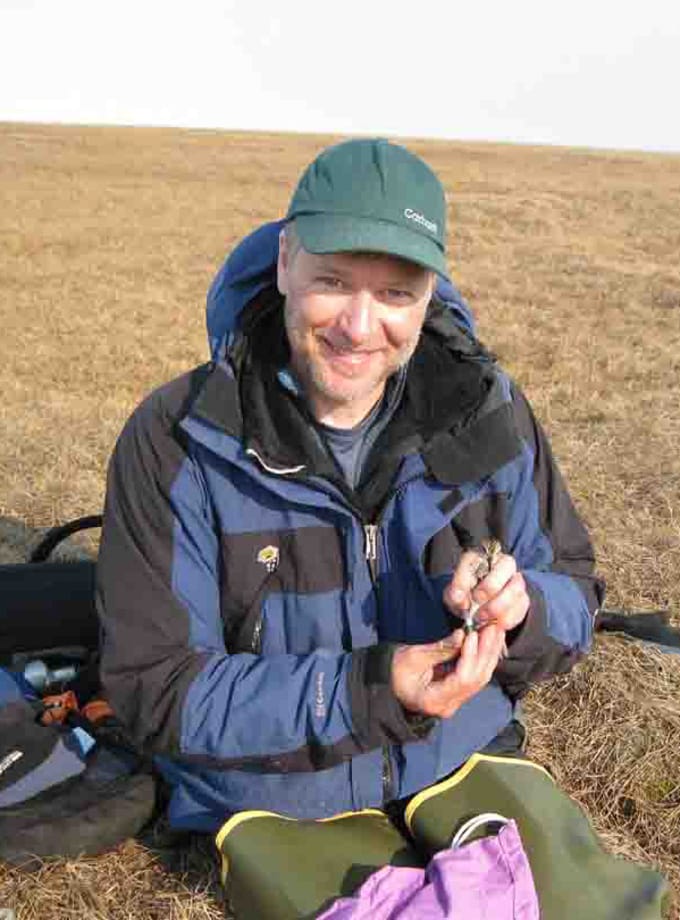
Stephen Brown, Ph.D.
VICE PRESIDENT, SCIENCE
Advances in shorebird science show the most important places for shorebirds.
Yukon-Kuskokwin Delta: 7 Million Breeding Birds
Manomet scientists help recover populations of declining shorebirds by identifying places most important to them for breeding, migration, or wintering. Three scientific papers were published recently that each help to advance this work. In collaboration with the U.S. Geological Survey, the U.S. Fish and Wildlife Service, and other partners, Manomet completed the first-ever survey of breeding shorebirds in the Yukon-Kuskokwin delta, a huge area of western Alaska known to be important for shorebirds, but that had never been fully surveyed.
Our results showed that the area supports over 7 million breeding birds, including large proportions of the populations of several species, including Pacific Golden-Plover, Black Turnstone, Western Sandpiper, and also one subspecies each of Bar-tailed Godwit, Whimbrel, and Dunlin. The population estimates will help us track changes in these species over time, and will also be combined with other information to generate global population estimates of each species so that we can identify the most important migration and wintering areas by comparing the numbers of birds that use each site relative to the entire population size, a critical aspect of identifying sites for the Western Hemisphere Shorebird Reserve Network (WHSRN), a critical network of 123 sites representing 20 countries, for which Manomet hosts and staffs the executive office.
Red Phalaropes: Tundra to the Sea
A second paper, also a collaboration led by U.S. Fish and Wildlife Service biologists and many other partners, established the most important migration areas for Red Phalaropes, an unusual shorebird species that nests in the tundra but migrates and winters at sea, more like a seabird. We found important stopover areas in onshore and nearshore habitats of the Beaufort and Chukchi seas, the western edge of the Bering Strait, along the Alaska Peninsula and Aleutian Islands, and near the Pribilof Islands in Alaska. Conservation of these areas and reduction of threats to birds at sea will be important for protecting populations of this unusual shorebird.
Shorebird Science and Conservation Collective: Satellite Transmitters
A third paper summarizes the work of a large partnership we participate in called the Shorebird Science and Conservation Collective. The group is led by the Smithsonian Migratory Bird Center, and we serve on the steering committee with several other key partners. In this partnership, we share our shorebird tracking data acquired by equipping birds with satellite transmitters throughout the Arctic. Advancements in tracking devices (in reduced size and weight) have allowed us to gather more precise and frequent data on many of the smaller shorebird species we are focused upon.
The Collective assembles data from many partners, and works to understand the conservation implications of the multi-species large data sets, including identifying the most important migration stopovers for shorebird species. Knowing what sites are the most important is key to successfully protecting them through site-focused conservation work, including participating in the Western Hemisphere Shorebird Reserve Network, which Manomet leads.
Dig Deeper: Manomet Publications Archive
Together all of these partnerships and the scientific papers that follow help improve our understanding of what places are most important to shorebirds, so they can be protected and conserved as we work toward recovering populations of these rapidly declining species. If you’re interested in learning more, you can read these (and many more) in the Manomet research archive at www.manomet.org/scientific-publications/. These projects were made possible by grants from the National Fish and Wildlife Foundation, the Knobloch Family Foundation, the U.S. Fish and Wildlife Service, the U.S. Geological Survey, donors to Manomet Conservation Sciences, and many other partners. Other work underway on the impacts of climate change on shorebirds helps us understand this critical threat – stay tuned for three more and we will summarize three other papers on climate change impacts when they are published soon.





 Back to all
Back to all


